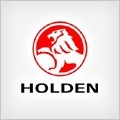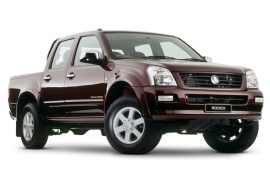
HOLDEN Rodeo
Generations Timeline, Specs and Pictures

When GM and Isuzu joined forces to create vehicles together, they received something needed from the other partner, and Holden was one of the biggest winners.
With its high expertise in building light utility vehicles, the American team designed and produced the chassis for the Chevrolet Colorado, which GM also used on other vehicles built the American carmaker under different names, including the Hummer H3 SUV. On the other hand, Isuzu was the biggest diesel-engine builder in the world and put its 2.5-liter and 3.0-liter turbo-diesel units on the table. As a result, GM benefited from that arrangement and sold a re-badged Isuzu D-Max on the Australian market under the Holden Rodeo nameplate.
Even if the car looked like the design team was the less-favored part in the project, it showed a rugged style, fit for the light pickup market. Its vertical headlights made room for a wider grille, needed mostly for the gasoline-powered versions. In its Double Cab form, the Rodeo offered a cabin with four doors fit for five adults.
Inside, the materials used were not of the highest quality, but they were built to last. Its hard-plastic dashboard and soft padding on the door panels offered an adequate compromise for the vehicle’s destination. The instrument cluster was carried over from Isuzu, with a large speedometer in the middle, flanked by a tachometer on the left and the fuel and temperature gauges on the right.
Unlike Isuzu, who offered the car mostly with diesel engines, and Chevrolet, who sold the Colorado with gasoline versions, Holden benefited from both versions. Power ranged between a 78 hp diesel unit and a 200 hp V-6 gasoline powerplant.

Holden was one of the brands that benefited from Isuzu and General Motors’ agreement, receiving the Rodeo lineup, which it introduced on the market in 2003.
Based on the Chevrolet’s Colorado chassis, the Holden Rodeo was a re-badged Isuzu D-Max sold in Australia and New Zeeland in a few body shapes. It was the workhorse in the Space-Cab version and a family-friendly vehicle in the Double-Cab version.
Even if the car looked like the design team was the less-favored part in the project, it showed a rugged style, fit for the light pickup market. Its vertical headlights made room for a wider grille, needed mainly for the gasoline-powered versions. On the sides, the car sported an additional set of windows behind the doors, with a pop-out opening system. Holden offered the Space Cab either as a chassis-cab or as a complete vehicle with a bed that provided a maximum length of 2270 mm (83.3”)
Inside, the materials used were not of the highest quality, but they were built to last. Its hard-plastic dashboard and soft padding on the door panels offered an adequate compromise for the vehicle’s destination. The instrument cluster was carried over from Isuzu, with a large speedometer in the middle, flanked by a tachometer on the left and the fuel and temperature gauges on the right. On top of the center stack, the carmaker installed three buttons for the 4x4 traction system.
Unlike Isuzu, who offered the car mostly with diesel engines, and Chevrolet, who sold the Colorado with gasoline versions, Holden benefited from both versions. Power ranged between a 78 hp diesel unit and a 200 hp V-6 gasoline powerplant.

Manufactured between 1996 and 2002, the Holden Ranger Double Cab offered a choice of seven engines, starting with a 2.2- and ending with a 3.2-liter, with maximum output rated at 188 horsepower. Combined with manual, 5 speed transmissions but equipped with all-wheel-drive systems, the 1996 Ranger is said to provide excellent handling, traction and comfort, no matter if we’re talking about regular roads or off-road environments. The Australian carmaker ceased production of this model in 2002 in order to concentrate on the upgraded version, still manufactured in 2008.























































